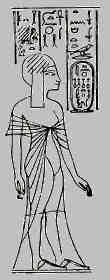Mutnedjmet [61742]
- Marriage: Horemheb [61743]

 General Notes: General Notes:
http://en.wikipedia.org/wiki/Mutnedjmet
Mutnedjmet (Mutnodjmet, Mutbenret) was an Egyptian noblewoman, the younger sister of Queen Nefertiti . It is highly likely that she was the same person as the wife of Horemheb , the last ruler of the Eighteenth Dynasty . The name, Mutnedjmet, translates as: Mut is sweet. It is also possible her name was Mutbenret (the hieroglyphs for nedjem and bener are similar and so is their meaning).
She appears in some of the Tombs of the Nobles at Amarna , particularly that of her possible father, Vizier Ay (Southern Tomb 25), where she is shown as a young girl. Her formal titles include 'The Sister of the King's Chief Wife' (indicating a direct relationship with Nefertiti), as well as: Singer of Hathor, Singer of Amun, King's Great Wife.
Mutnedjmet is occasionally shown accompanying Nefertiti's three eldest daughters (Meritaten , Meketaten , and Ankhesenpaaten ) in reliefs. Additionally, Mutnedjmet is sometimes depicted in the company of two court dwarfs. It is speculated that an alabaster piece found in Tutankhamen 's tomb of a boat carrying a lady with a dwarf represents Mutnedjmet with one of these men. She is known to have usurped a number of inscriptions of Ankhesenamun at Luxor temple and appears with her husband at the latter's coronation on a statue in Turin Museum.[1]
Not much is known about the period following Nefertiti's death.[2] This practise would echo the decision of Ay, Horemheb's predecessor who married Tutankhamun's wife in order to legitimise his kingship. Other Egyptologist such as Geoffrey Martin note that there is no definite evidence to prove this assertion.[3] Martin writes that:
The name Mutnodjmet was not particularly rare in the late Eighteenth Dynasty, and even if she were the sister of Nefertiti her marriage to Horemheb would have had no effect on Nakhmin's legitimacy or candidacy since Mutnodjmet (who is depicted in the private tombs at El-Amarna) was not herself of royal blood. In any case whatever her antecedents Mutnodjmet could have been married to Horemheb a little before he became Pharaoh.[4]
Mutnedjmet died soon after Year 13 of her husband's rule in her mid-40s based on a wine-jar docket found in a burial chamber of Horemheb tomb at Saqqara , in Memphis and a statue and other items of hers found here.[5] The mummy was found in King Horemheb's unused Memphite tomb along with the mummy of a still-born, premature infant. She appears to have been buried in the Memphite tomb of Horemheb, alongside his first wife Amenia . Mutnedjmet's mummy shows she had given birth several times, but the last King of the 18th dynasty did not have a living heir at the time of his demise. It has been suggested that she had a daughter who was simply not mentioned on any monuments. The presence of the infant along with Mutnedjmet in the tomb suggests that this queen died in childbirth. A canopic jar of the Queen is now located in the British Museum.[6]
It is possible that the tomb QV33 in the Valley of the Queens was originally built for her. The tomb is known as the tomb of an otherwise unknown Tanedjmet, but both cartouches with her name are damaged and the similar hieroglyphs for ta and mut allow for this interpretation.[7]
Footnotes
1. ^ Aidan Dodson & Dyan Hilton, The Complete Royal Families of Ancient Egypt, p.156
2. ^ Joyce Tyldesley, Chronicle of the Queens of Egypt, 2006, Thames & Hudson, p.140
3. ^ Geoffrey Martin, The Hidden Tombs of Memphis, Thames & Hudson (1991), p.96
4. ^ Martin, p.96
5. ^ Dodson & Hilton, p.156
6. ^ Dodson & Hilton, p.156
7. ^ Elizabeth Thomas: Was Queen Mutnedjmet the Owner of Tomb 33 in the Valley of the Queens? in: The Journal of Egyptian Archaeology, Vol. 53, (Dec., 1967), pp. 161-163

Mutnedjmet married Horemheb [61743] [MRIN: 551617779]. (Horemheb [61743] died in 1292 B.C. and was buried in KV57.)
|

